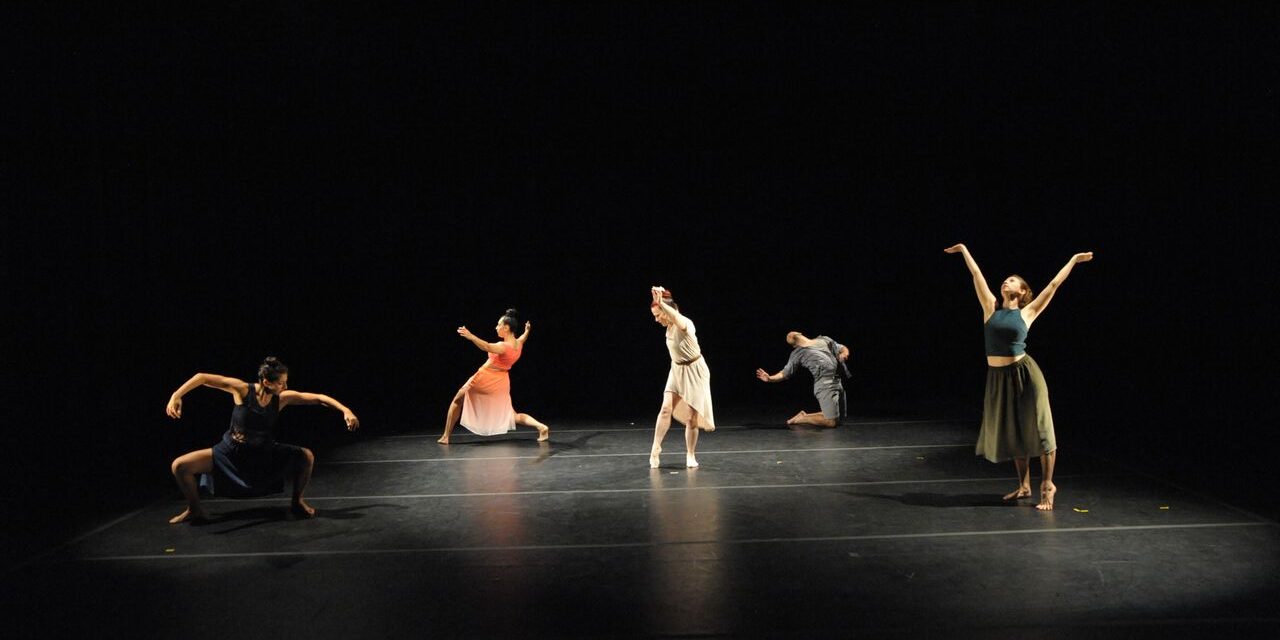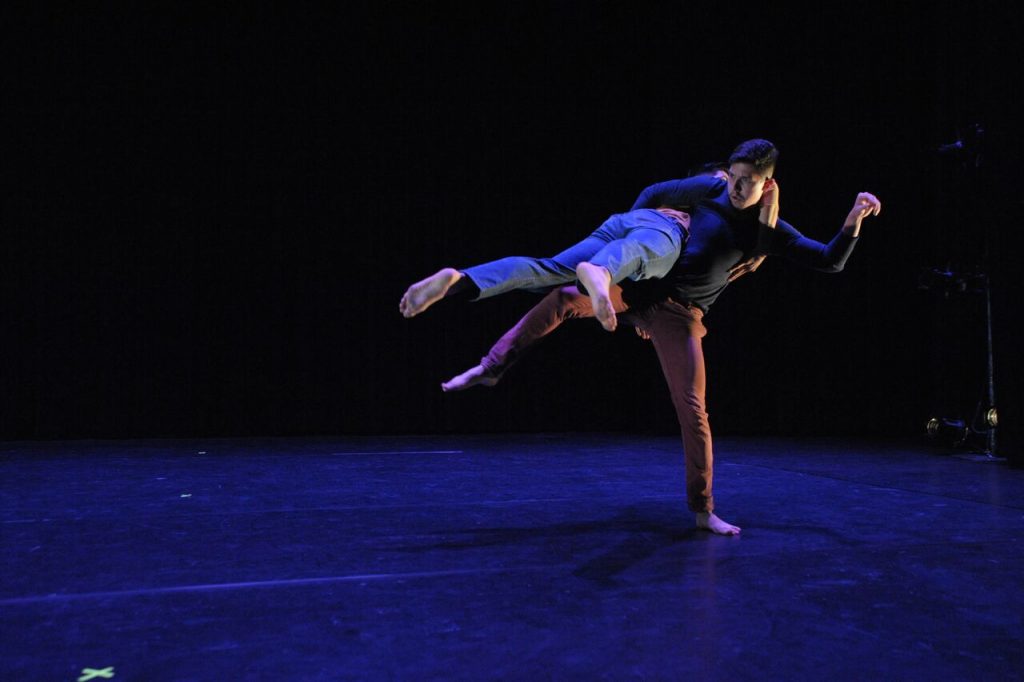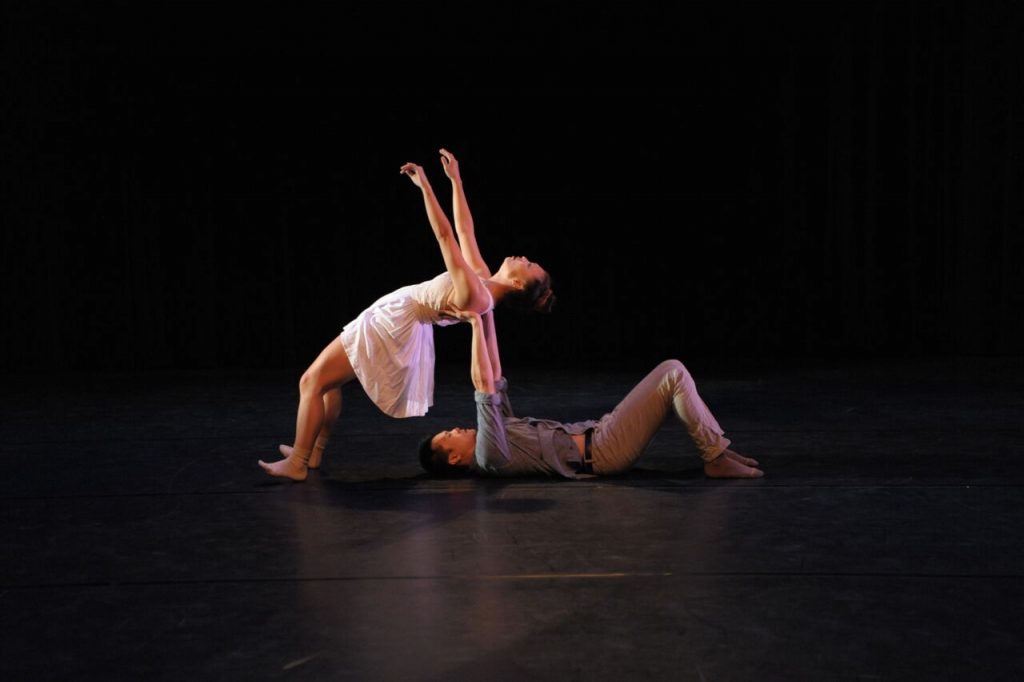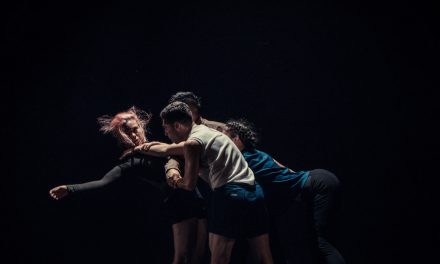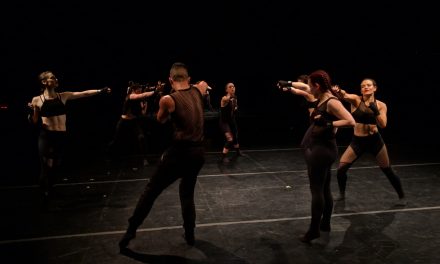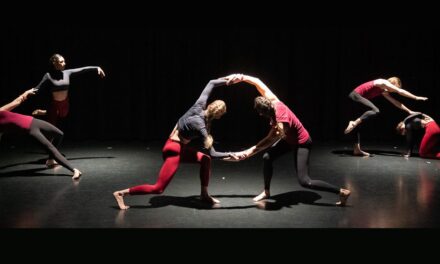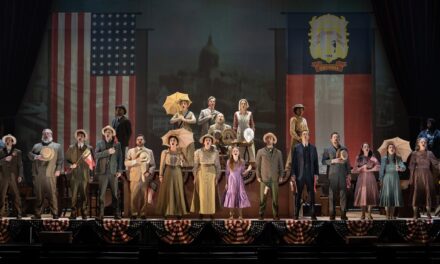On August 25 and 26, FUSE Dance Company presented SYNTHESIS V at the Brea Curtis Theatre with mixed results from the 12 participating choreographers. The uneven production included many forgettable pieces among which a few choice selections stuck out like diamonds in the rough, providing a subtle glance at what may be in store for LA and Orange County’s upcoming year in dance.
The evening (or afternoon, for those attending Sunday’s 5pm show) had a rough start with ViHu Dance’s Disintegrated Image. Mainly characterized by consistent, soldier-like marching to industrial music (Sean O’Neal), Victor Hugo’s routine centered on societal expectations to fit in. Every few boxy steps, the ensemble’s synchronicity would be interrupted by a dancer who would stumble, frantically waving their arms in confusion before falling back into formation. Leland Stephen’s eye-catching costumes (perhaps the best of the night) of black and white suits with varying colorful, neon patches gave the troupe a cool look that allowed viewers to keep track of the individuals whose faltering would dissolve the picture of pristine unanimity dominating the majority of the ensemble’s movements.
In between moments of unison, the entire group would take sudden and random “dance breaks,” free styling awkwardly as if at a club with each member spastically performing on their own before realigning to march and often clumsily taking more than a few seconds to get back in sync with one another. As the piece went on, it interrupted itself more frequently with scenes that celebrated original movement. They started off as breaths of relief from the repetitive stomping, but quickly led to unfunny and cooky choices such as Edward Salas loudly yelling, “Chicken nuggets!” at the top of his lungs with no explanation. Watching these brief segments unfold was like seeing a machine short circuit—they added nothing positive to the overall message about anti-conformity. The company looked much better when performing as a unit, which may not have been their intention.
Chemical Kinetics by The Reach Sister Dance Company was an entirely different dance, which focused on contemporary movement that flowed as well as Disintegrated Image did not. Savannah Reach’s choreography may not have been particularly groundbreaking, but the execution was pleasant to watch—very natural with beautiful extensions and light jumps performed to pretty piano music (Ólafur Arnalds and Jon Hopkins). The calm moments in their routine were juxtaposed by eruptions that matched the suddenly thunderous playing of the piano, creating lovely contrast with bold leaps and quick turns that added interest to the piece.
WYRD by Psychopomb Dance Theater became one of the most memorable works in the entire showcase. Designed as a military exercise that compared strict and forceful moves with gentleness, Shenandoah Harris’ choreography was a dance of empathy and friendship. The three women on stage, Maijalisa Miltz, Kaycee Janino and Sam Rose wore green military pants and white sports bras that showed off their muscular physiques. Monkey rolls were a large part of their performance, occurring over and over again as though part of a training discipline. Sharp animal noises and, later, a suspenseful movie-like score created a creepy soundscape (Wadruna) and backdrop for their movements. The dancers’ sharp athleticism was paired with delicate hugs and gatherings during which two of the women would cover the third’s eyes, shielding her from some unknown horror, creating a visible connection between them when performing as a a trio. The bond they created brought them together much in the same way a platoon might unite when preparing for battle.
Four dancers—Heidi Trew, Kaitlin Wright, Krissy Ray and Sara Slagle—gathered around a standing light, fascinated by its glow. Some of the characters’ attention was completely consumed by its appearance, as they took turns stepping closer to the stand, and stealing the bulb from one another. One dancer stood out as wanting nothing to do with the light at first. Kaitlin Wright, the tallest of the four, did the running man away from the bulb in a desperate attempt to escape from the knowledge or truth the prop represented. Her loud, distracting stomps clashed with the rest of the ensemble’s wavering attempts to get close, and only occasionally breaking away from the lamp. Much of this back-and-forth became repetitive until the last third of the dance when Wright’s resistance turned into obsession. As her company members brought the light closer to her, her face showed longing, which was matched by quick dancing around the light. She reached out to it a few times in an attempt to bring it closer to her before finally turning away, dramatically and confidently walking off stage after it was presented to her a third time, like an addict breaking a bad habit. The rest followed suit.
Peri Trono’s Cradled Bones didn’t add much to the evening of dance. The music (Bliss) contained curious whispers and inaudible mumbles that may have meant to shroud the piece with mystery. However, his work was either strange or clumsily executed. Neither the dancers’ facial expressions, nor their movements matched any of the ominous tones established by the soundscape—rather than blank, they mostly looked bored. Sharp twitches did sync with the snapping-like background beat, but the trio’s backward arm rolls seemed floppy, while their low leg kicks and extensions lacked energy. John Paul Alejandro stood out amongst the three as having the best lines, spinning and hitting each new position with more purpose than his counterparts. However, the fact that some of the sections they performed together were slightly out of sync showed that the piece may have needed more time and fine tuning.
Sense of Themselves by Emily Upcraft and Between Seconds by Emergent Dance Company’s Megan Pulfer were the two showstoppers that concluded the first half of SYNTHESIS V. Both brought the showcase back up to WYRD standards with their creative choreography and precise synchronicity. Each company was dressed in all black and entirely composed of women.
Sense of Themselves went on first with a soulful exploration of individuality to a melodic, unnamed song by Loscil and Nis Frahm. The group of six began by keeping their movements united. Slow and steady, they moved in waves, gathering together and pulling on each other’s arms while spinning. Two broke away from the ensemble to perform a mirrored duet where they played off of each other’s strengths and lifted one another into the air during the soundtrack’s crescendos. Throughout the dance, the performers relied on one another for balance and support until the characters became more confident in their dancing, transforming their clingy embraces and backward trust falls into solo-centered pieces. The dance’s focal point came toward the end when the group gathered in a circle around a spotlight, leading to a triumphant moment of self-realization during which they lifted one of the dancers up in the center. The image of her head cocked back and eyes closed made the scene appear like a religious cleansing and purification.
Between Seconds took on a different approach with music reminiscent of ’80s techno (Chromatics and Album Leaf). The seven-member troupe formed a circle and immediately began striking angular poses as they rotated in quick steps around a spotlight, bending their arms at 90 degrees and maintaining a small bounce in their step that kept in time with the beats. The group’s signature move became the rotation of one arm in a circle starting from their elbows. This small token focused the audience’s attention and added a sassy flair to their movements. Dancers split off into pairs to perform short bits consisting of high knee rises and sharp kicks, and later trios who took center stage and ran in place to emphasize the music’s pace before forming another circle. Forward shoulder shimmies reinforced their cool attitude and the exactness of their execution added a professional vibe to the company that was missing from a lot of the other SYNTHESIS V participants.
The second act began and closed with two pieces by FUSE Dance Company. The opening number was One Nation by the main ensemble, while the finale was just labeled the “FUSE Intensive Piece”. Both were choreographed by artistic director Joshua D. Estrada-Romero and showed the difference between his fully fledged dancers and those who have not yet reached their full potential, but are working on honing their skills.
One Nation was among the most original in its format. The work’s staging was its most memorable factor. Set to music by Loscil, Estrada-Romero’s routine began with the dancers, dressed in black, standing in a diagonal line and shifting their weight from one foot to the other as they teetered slowly from side-to-side. As the music evolved, dancers broke away from the formation two at a time to subtly make their way off stage only to return in solid-colored contemporary clothing. The dance would evolve after every couple troupe members underwent a wardrobe change. While the remaining colorless dancers performed the same movements, those dressed in red, orange, blue, etc. would exercise their own, more creative and diversified choreography, perpetually dividing the stage in two. Black bounced in unison while color cradled one another, added more turns and usually maintained physical contact in a way that made them seem more emotionally in tune with each other than their dark-clad counterparts. The rainbow dancers continued to add members to their side until black disappeared completely and the stage became full of bright and pastel–dressed bodies dancing—a metaphor for celebrating a cohesive, but mosaic single nation.
The “FUSE Intensive Piece”, on the other hand, did not necessarily carry the same oomph in its choreography. The result was a more generic-looking piece that had one focusing on the dancers’ ability more so than the routine, which mostly consisted of swift lifts and the same, smooth modern dance feel present in much of Estrada-Romero’s work. Stand outs included Chandler Davids, Miguel Huerta and Norianna Galindo-Ramirez for the clarity of their movements and swift transitions.
The rest of the pieces sandwiched in between FUSE Dance Company’s two presentations were more diversified than those featured in the first half of SYNTHESIS V, with many pieces breaking away from the modern and contemporary dance company structure seen in the first seven works.
Marika Brussel’s Falls Like Rain immediately followed One Nation with a duet to music by Oliver Davis. Dramatic violins accompanied a classical and modern–mixed ballet, the only one of the evening. Theresa Knudson and Calvin Thomas portrayed a love story full of longing and warm, drawn out embraces with delicate gestures—a charming one included Knudson tracing Thomas’ forearm with her fingers before softly nestling her head in the crook of his neck as he spun with her in his arms. Their partnership reflected the characters’ physical and emotional codependence well. They concluded their piece to one of the strongest and most positive reactions from the audience via roaring applause.
mBody Dance Company’s Women of the Canvas took the show in a completely new direction by paralleling three different forms of dance, each presented by one performer—Sierra Rae Kellogg was contemporary dance, Marta Serra did Flamenco and Kundson, fresh from her duet with Thomas, covered ballet. Sara Vincent’s choreography was able to weave the three solos together and make them into one cohesive piece. The music (Ulysse) had an exotic flavor which worked well with all three sections. Each featured one of dancers doing a brief, yet mostly emblematic routine underlying key movements from their represented genre. The other two then mimicked a few of the more iconic ones, such as the hip roles and turns in Serra’s Flamenco skirt dancing routine, giving the whole thing the appearance of backup singers supporting a starlet. After each woman had their turn, the trio departed much in the same way they entered—in a single file with short, toe-heel steps that led them off stage. Their piece highlighted one of the aspects SYNTHESIS V felt like it was missing—more diversity.
Our Love related back to the theme presented in Falls Like Rain, but with a completely different style and approach. Designed as a love story, the couple (dancer/choreographers Davids and Ashley Diamond), dressed in everyday blue clothing, played with distance in their routine. Through turns that pushed them apart, then brought them back together, they were able to stay connected by mirroring each other’s extensions when farthest from one anther on stage. They maintained eye contact throughout their separation before reuniting with dramatic lifts and tugs to music sung by James Blake. The number was brief, cute and had less of an impact than its ballet counterpart.
Down the Line by Roots & Wings Dance Project was a bit gimmicky with its use of three or four rows of long strings tied to chairs that were carried off stage before the music (Arnalds) began. Shirine Rehmani’s choreography was not especially remarkable—rather a contemporary piece with plenty of spins and leg extensions that included the dancers wrapping themselves in the rope, either at the waist or by their arms and legs. Their motion followed the left-to-right/right-to-left direction of the strings and included some limbo-like ducking as a way to maneuver beneath the lines and quick hopping to amble over them, creating a little more range in their movement.
Invincible Summer by Caitlin M. Heflin was the last number before the “FUSE Intensive Piece” finale. Melancholic strings became the backdrop for a single dancer’s isolation from her friends. As she sat rocking in a chair, the rest of the troupe ran back and forth diagonally to her from across the stage, often stopping to look into her face while she stared into the audience. The performer’s looks were more blank than haunting, even as she stood to dance. Her struggle seemed perpetuated by her friends’ interference as they formed a circle around her and pushed and pulled her within their constructed cage, unsuccessfully guiding her restricted movements through stumbles. The majority of her dancing took place separately from the rest of the group, which moved in unison. Every time she approached them, they slowly stepped backward, often just watching her perform sad solos that featured her faltering on one foot and dragging her body in sudden imbalanced whirlwinds across the space. The piece concluded much as it started—with the lonely dancer sanding alone and feeling more ostracized from the crowd, resulting in a downer of an ending that directly juxtaposed Disintegrated Image’s opening number about breaking free from the majority.
Altogether, SYNTHESIS V could have benefited from including more variety and diversity in both the type of modern and contemporary dance that was presented, as well as among the dancers themselves. The middle portion of the program, which consisted of the last part of the first act and beginning of the second, was the most innovative part of the show. Although SYNTHESIS V didn’t quite begin with a bang, its quirky opening served the show better than its closer, which would have benefited from being more powerful and memorable in order to help build anticipation for a better SYNTHESIS VI.
To learn more about FUSE Dance Company, Click here.
Featured image: FUSE Dance Company – Photo by Edwin Lockwood

